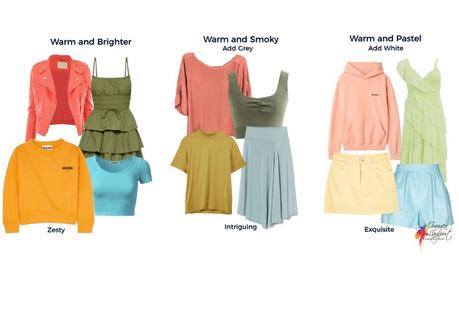



If you’ve had a colour analysis in the past and discovered that you have a warm skintone (undertone) or warm season, what do you do when your hair goes gray? How does this change the colours that suit you?
&iv;&modestbranding;&rel;&autohide;&playsinline;&autoplay;
Navigating Your Colour Palette When Your Hair Turns White or Gray
As we age, one of the more noticeable changes is the transition of our hair colour. Whether it’s turning silver, grey, or white, this change can leave many wondering how it impacts their personal style and, more specifically, their colour choices. Recently, a client asked a common question:
“My hair has gone white-grey, but I still have a warm complexion. I’m not sure which colours work for me anymore.”
This question is a perfect starting point to discuss the importance of reassessing your colour palette when your hair changes colour. Let’s break down how this transition can affect your style and which steps you can take to ensure you’re wearing the most flattering colours for your current look.
The Impact of White or Gray Hair on Your Colour Palette
Your hair plays a significant role in determining your best colour palette. When your hair shifts to white or grey, it introduces new contrasts in your overall appearance, meaning the colours that suited you before might no longer have the same effect. However, not everyone with grey or white hair falls into the same category. Here’s what to consider:
- Is your hair truly white, or more of a grey? If your hair is closer to white-white, you might find that lighter, more pastel shades are now more flattering. For example, my Exquisite palette with soft warm pastel hues may suit you, bringing a harmonious balance to your lighter hair. However, if your hair is still grayer, a softer colour palette with less brightness might work better (such as my Intriguing palette) —one that aligns with the muted tones of grey hair.
- What about your skin tone? While your hair colour changes, your skin tone may remain warm or cool down. If you still have a warm complexion, you’ll want to stick with the warm colours that have always complemented your skin. However, the intensity of those warm tones might need to soften, especially if your hair has lost some of the warmth it had when you were younger. Check out my real-life post of a client with warm undertone who has embraced her grey.

- Notice how both the Warm and Smoky and Warm and Pastel colours are softer than the Warm and Brighter colours, but adding grey makes the colours more muted than adding white.
Understanding Colour Continuums
When deciding on the right colours, it’s helpful to think about the different continuums in colour analysis:
- Warm vs. Cool: Just because your hair has lightened doesn’t mean you need to move to an entirely cool palette. Warm skin tones still benefit from warm hues, but you might need to adjust how deep and vibrant those colours are. They may not be as warm as they once were, even though they still have a warm undertone.
- Light vs. Dark: Your hair colour lightening will mean a shift toward lighter shades. If your hair is now white or very light grey, embracing softer, lighter colours that mirror this change can bring harmony to your overall look. Darker colours will appear heavier and weigh you down.
- Bright vs. Muted: As your hair loses its vibrancy, colours that are too bright or saturated might feel overwhelming. Smoky colours that blend smoothly with the grey or white tones can often create a more elegant and refined appearance. Once you’ve gone completely white your hair brightens up again and you may move to a slightly brighter less muted palette once more.
The Importance of a Colour Update
If you’ve noticed that your go-to colours aren’t as flattering as they used to be, it’s likely time for a reassessment of your palette. The shades that once suited you may now feel too harsh or too bold, while others you never considered might be more suitable. Don’t worry that softer colours will make you fade away.
Here’s a rule of thumb: when your hair colour changes, it’s a great time to refresh your colour analysis. By updating your palette, you can align your wardrobe with your current look and continue feeling confident in every outfit.
Plus your colour and value contrast will change along with the hair colour changes, so how you put colours together from your palette will differ as well.
Final Thoughts
Transitioning into white or grey hair is an interesting process (to say the least), it can bring up emotions that may surprise you, you may find it freeing in a way you never expected, or you may feel like it’s a sign that you’ll never be as young as you feel inside but with the right colours, you can enhance the grace and elegance it brings. The key is to assess where you fall on the various colour continuums and adjust your palette accordingly. This allows you to reflect your current characteristics through the clothes you wear, ensuring that your style evolves with you.
So, if you’re feeling like your colours aren’t quite working as well as they used to, consider scheduling a colour reassessment. It’s a powerful way to keep your style fresh and aligned with who you are today.
Want to get an idea of these kinds of colours in clothing? Check out my Amazon colour store – look at the Intriguing and Exquisite shops to see the difference between these colours.
Have you experienced a hair colour transition and noticed changes in your colour preferences? Let me know in the comments below—I’d love to hear how you’re navigating your own journey!
Busted! 7 Myths About Personal Colour Analysis Holding You Back From Your Perfect Palette
Personal Colour Analysis: The Hot New Old Trend
Finding Your Perfect Palette: The Evolution of Personal Colour Analysis
Understanding Colour Systems and Personal Colour Analysis







